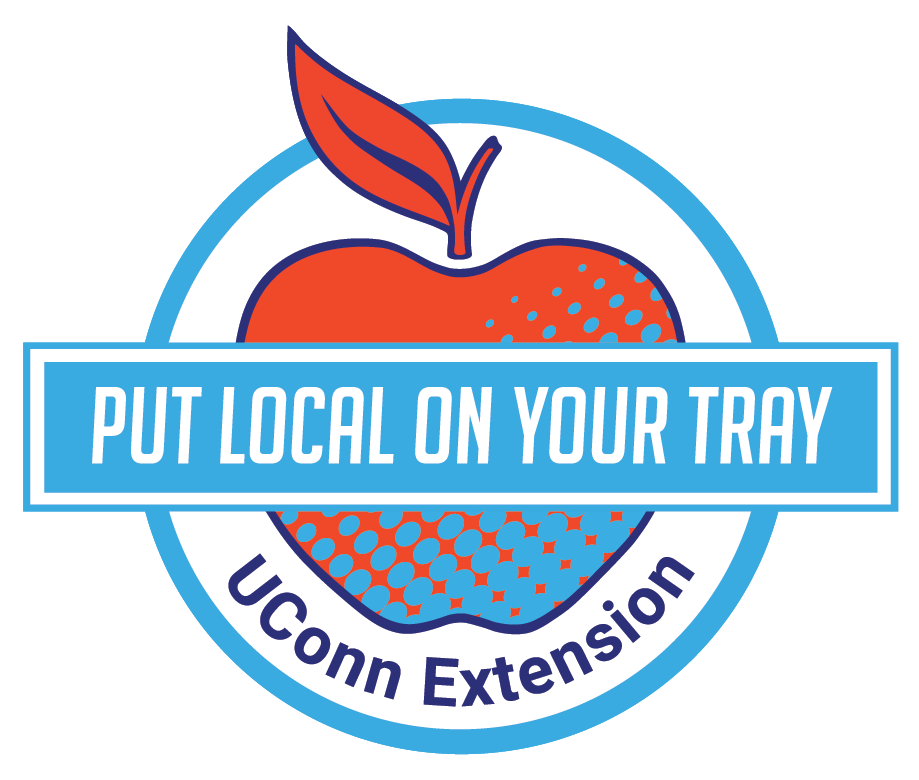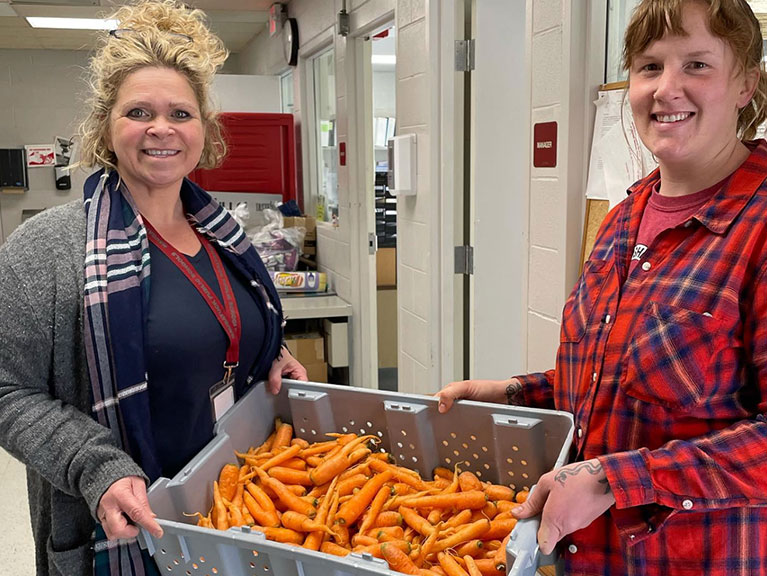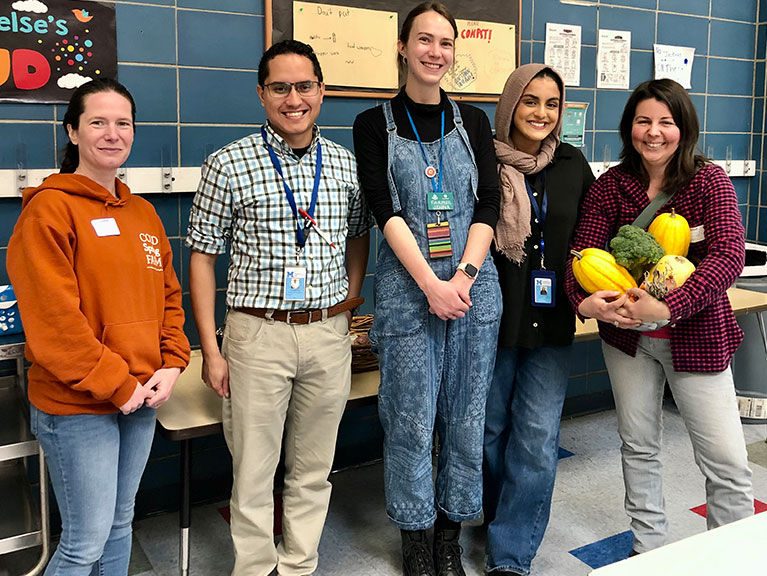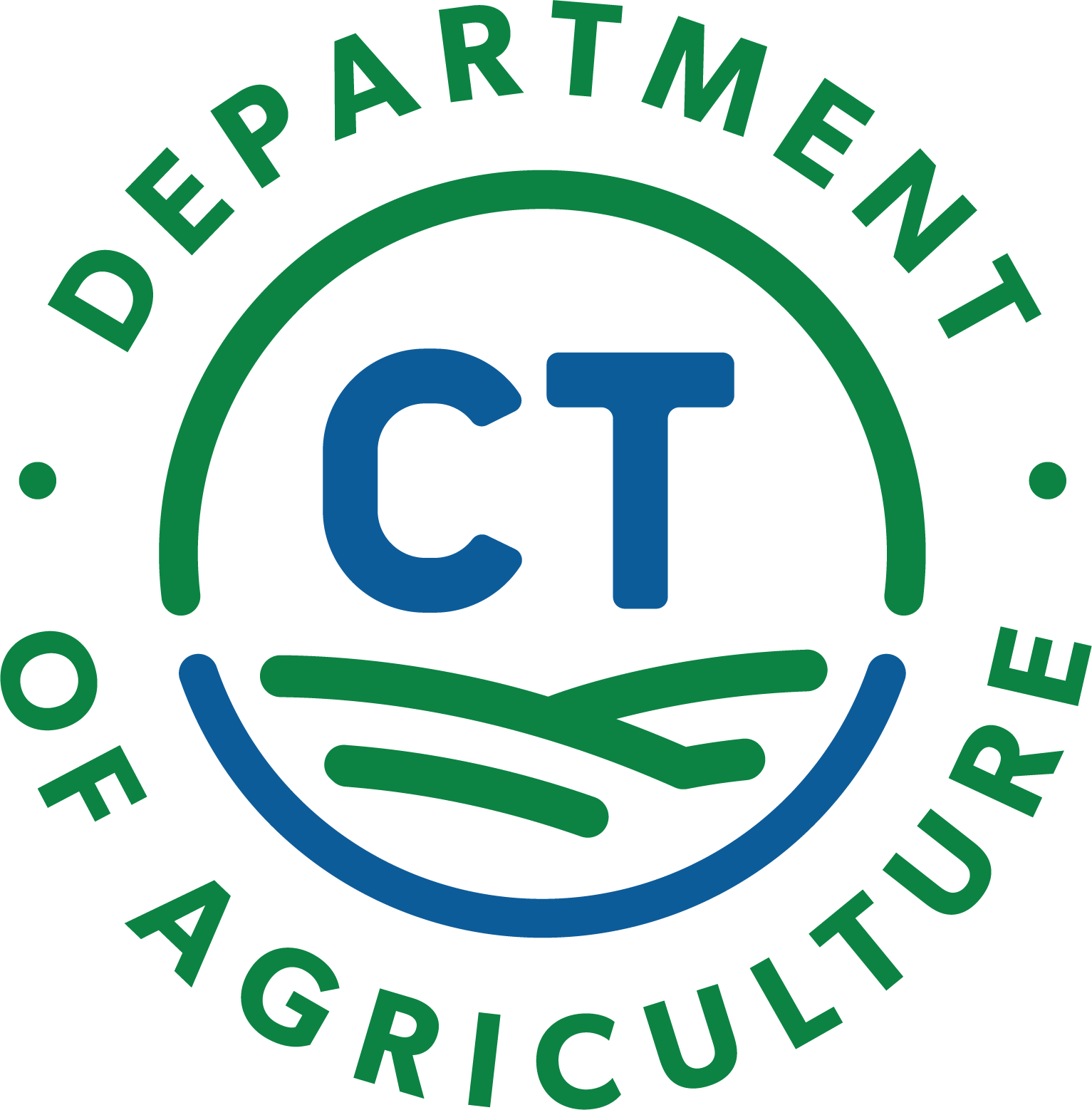Direct From the Farm
(Put Local on Your Tray Toolkit)
Author: Jiff Martin and Shannon Raider
(860) 870-6932
jiff.martin@uconn.edu
Reviewers: Cyrena Thibodeau, CTDOG and Monica Pacheco, Associate Education Consultant, Connecticut State Department of Education
Publication EXT 066 | September 2024
Direct From the Farm
Micro Purchase & Small Purchase Procurement Methods for K-12 Public Schools in Connecticut
Direct purchasing from small farm businesses is the shortest distance between your cafeteria and locally grown fruits, vegetables, added value dairy, meat, maple, honey, and more.
Understanding the Micro Purchase Threshold and Small Purchase Threshold are two great ways to purchase seasonal farm products without requiring complicated bids or contracts. A great way to build a successful relationship with small farm businesses is to lead with micro purchasing or small purchasing methods, also called “informal purchase” methods. This is critical since large purchases and contracts can be overwhelming and burdensome for small farms.
UConn Extension's Put Local on Your Tray has created this tool to help lay out the when, why and how to utilize these two procurement methods for direct purchasing from Connecticut local farms.
Reasons you may want to use micro purchasing or small purchasing:
- Save on administrative time and cost.
- Last minute purchases/delivery shortages.
- Small volume purchases (such as for a taste test or due to limited storage).
- Seasonal or local purchase ‘bumper crop’ prices.
- Support "socially disadvantaged" farmers and small businesses.
- Diversify your options for buying fresh food.
Increasing efficiency to bring locally grown products to school food service programs.
Use this Toolkit to:
- Learn the elements of and differences between micro purchasing and small purchasing.
- Learn how to find and connect with local farms and conversation starter recommendations.
- Answers to frequently asked questions and testimonials.
- Access templates for creating an invoice system and recording transactions in a procurement log.

Micro Purchase vs. Small Purchase
Micro Purchases
The micro purchase threshold is the most nimble and efficient way to start out on your local purchasing/direct purchasing relationships. Once you get in a regular purchasing relationship with a few farms, you move to small purchase.
- Quotes not required if School Food Authority (SFA) considers the price to be reasonable.
- Cannot exceed $10,000 or your district's limit per invoice.
- Aggregate dollar amount is set by your Board of Education.
- Need to be dispersed equitably among qualified suppliers to the maximum extent practicable.
- Buy American provision is required.
- Document all micro purchases and retain invoices (see appendix at bottom of the page for template).
- Micro purchase should be included as an approved use in your Procurement Policy.
In 2019, USDA-FNS published a memorandum that effectively raised the federal micro purchase threshold from $3500 to $10,000, and increased the federal simplified acquisition threshold (formerly known as the small purchase) from $150,000 to $250,000. To see a full explanation of the “revised, federal micro purchase and simplified acquisition thresholds” from USDA go to fns.usda.gov/f2s/procuring-local-foods.

Elements of a Micro Purchase
When to Use
- Quick purchases
- Purchases under the district micro purchase threshold
- Last minute opportunities
- When you only need to purchase lower volumes - ie. taste tests, menu extras or cultural celebrations
How You Do It
- Identify a farm and product(s)
- Agree on a reasonable price
- Keep record of the transaction-see Forms and Addendums
What to Know
- Threshold is either $10,000 or your district's limit, whichever is lower
- Threshold is PER INVOICE
- Rotate purchases among farms

“As a midsize farm, selling to schools has allowed us to reach a new part of our community. Working with our local district allows us to connect with families about the origin of their food. Selling to schools has become a regular part of our weekly orders routine.“ Kaitlyn Kimball, Sunset Farm Naugatuck
Small Purchases
With small purchase threshold, you can use geographic preference or other discretionary experience for the determining factor in deciding between similar vendors. You justify your procurement decision. Geographic preference is intended for larger purchases but can be useful to keep in mind when gathering quotes.
- Awarded when 3 quotes are obtained from 3 different farms.
- Quotes can be accepted via phone call, email, in person but must be tracked in writing.
- Acceptable quotes can include "product not available."
- Can be awarded to farm that best meets product specifications, not lowest bid, including geographic preference.
- Threshold limit is per invoice.
- Buy American provision is required.
- Cannot exceed the federal threshold of $250,000 or your district’s limit per transaction.
- Document all small purchases and retain invoices (see appendix for templates).
- Small purchase should be included as an approved use in your Procurement Policy.

Elements of a Small Purchase
When to Use
- When able to plan out purchases over a few weeks or months (vs. the whole year)
- A transaction (invoice) amount falls under the "small purchase" threshold
- Establishing regular purchasing relationships with 3-4 farms
How You Do It
- Identify a farm and product
- Get 3 quotes—a farm that responds “not available” counts as one of the 3!
- Keep records of quotes and purchases—see Forms and Addendums
What to Know
- Threshold is for single procurement
- Rotate purchases between any farms
- Can use the same farms for quotes for several purchases
- Document all bids and award winning bid in writing
“We have sold ethnic crops, including bok choy, collard greens, and callaloo, to the school district ... We are thankful to have a flexible contract with the school. They [school food services] can also adapt and take in produce when we have high volumes and has been able to adjust their pricing to help farmers receive competitive market value.” Emmanuel Marte, Micro2Life, Simsbury

Finding Farms
Connecticut has a rich and varied agricultural landscape that produces year-round products you can serve in your cafeterias! Finding farms you can work with is a commitment to building a lasting relationship that will benefit the farming community, students and the broader school community. Here are a few ways you can start discovering farms in your area:
- Visit your local farmers markets and introduce yourself.
- Check out online resources that identify local farms such as Put Local on Your Tray's "Farm to School Directory" and CT NOFA Farm and Food Guide.
- Look for a food hub option in your region.
Tips for connecting:
Be persistent! Call and email. Depending on the season, farmers work 10+ hour days outside. Evening and lunchtime are the best times to catch them at a desk, especially in late spring, summer and early fall.
- Late fall into winter is the BEST time to plan. Farmers are creating their crop plans and buying seeds.
- Get your talking points together! Use the adjacent Conversation Guide to organize an efficient and useful conversation!
- Connect with other food service directors at events to learn who they are working with and what resources they have used at the CT Department of Agriculture, State Department of Education and UConn Extension.

“Our commitment to working directly with farmers has not only strengthened our ties to the local agricultural community but has also ignited enthusiasm among students and families. Streamlining procurement is achievable by starting with manageable, micro purchases and gradually expanding based on your evolving needs.” Randall Mel, Middletown Food and Nutrition Manager
A Conversation Guide for Food Service Directors
These questions are a guide for an initial meeting between a Food Service Director (FSD) and a local farmer. Questions, from the buyer’s perspective, reflect the key issues expressed by FSD’s in connecting for direct purchases. Both the farmer and the FSD should come together with curiosity and a willingness to listen, adapt, and be creative. Start small, try something, and grow from what you learn.
Getting to Know the Farm
- Can you share a little about your business values/philosophy and your farm?
- Are you interested in supplying products to schools? Do you already sell directly to schools or other institutions?
- What do you grow well that you could scale up? What do you grow efficiently?
- How do you come up with the cost per unit? Do you have a price and/or availability sheet?
- Can you describe your wash and pack process? How do you handle different products? E.g. tomatoes or peppers vs. lettuce or kale?
- How do you hold different fruits and vegetables?
- Are you open and able to do farm tours for students and/or staff?
- Would you be willing to consider growing specifically to sell to our district?
Logistics
- What is your preferred method of communication, phone, fax, email, other?
- How do you communicate if there is a delivery problem or product quality is not what it should be etc?
- Schools require invoicing. Do you have a system to send an invoice? It takes our district ___ weeks to process payment. Can the invoice be itemized?
- How far in advance can you tell me what product you will have and when it will be available?
- How much lead time do you need for my orders?
- Can you describe your pack style: box size, weight, volume fill vs. tray pack etc?
- On average, how much time between harvest and delivery? This question is important when utilizing geographic preference language.
- Let’s talk about delivery (Note: Be clear on what you need. Be open to compromise. E.g. if you need product delivered to several schools, maybe you can work to minimize delivery locations.)
- Do you have a minimum order amount?
- What type of bins or boxes will the delivery be in? Do they need to be returned?
- What quality control (food safety processes) do you have on your farm to ensure the product is safe? Can you share any classes or food safety trainings you have done? Do you have a standard operating procedure (SOP) to train employees on best practices?
Frequently Asked Questions
Choosing Micro Purchase or Small Purchase
When do I use Micro Purchase vs. Small Purchase?
When you are starting out with a new farm or a new product, the micro purchase is usually the best option. Use small purchase if you have been buying from one farm business or a specific product consistently over time or if the per invoice amount is more than $10,000 (or district limit) but less than $250,000 (or district limit).
How often can I use either the Micro Purchase or Small Purchase?
You can use either micro purchase or small purchase as often as needed as long as you are following the requirements.
How does it work to shop at a farmers market?
Shopping at a farmers market would most likely be a micro purchase. Keep records of your purchases including the farm, the product, and the price.
How does a food hub fit into this?
The food hub is the entity, so it would count as a single seller. Your first purchase from a food hub might be a micro purchase, but if you find yourself relying on the food hub for frequent purchases it may be time for three quotes and a transition to small purchase.
Where can I find the Micro Purchase Threshold for my district?
The local Board of Education sets this level. Ask your business manager to find the regs from BOE Policy Book 3300 series.
What's the difference between the Micro Purchase Threshold for my district and the Federal Micro Purchase Threshold?
Municipalities in Connecticut establish micro purchase thresholds for making purchases without competitive bidding. The Federal threshold is often higher than a municipal threshold, and SFAs must use whichever is lower. The federal thresholds are $10,000 for micro purchase and $250,000 for small purchase.
How do you determine and track what is a reasonable price?
What you, the SFA, considers reasonable is based on your experience and personal knowledge of the items being purchased. Review purchase history and compare with previous purchases of similar items. Consider adding a note on the invoice. At this time, the Connecticut State Department of Education (CSDE) is not seeking formal documentation of reasonable price for purchases using micro purchase. For small purchase, you will use the three quotes to demonstrate price comparisons. However, you do not have to rely on price only to choose your supplier with small purchase; you may also use characteristics of the product (such as availability of delivery) and geographical preference.
Multiple Purchases and Multiple Suppliers
How many times can I purchase from the same farm in a year?
For purchases that fall under the Micro Purchase Threshold of your district (or below the federal threshold of $10,000, whichever is lower), you can go back multiple times in a year to the same farm as long as you are showing good faith and trying to equitably spread purchases among qualified sources.
When should I shift from Micro Purchase to Small Purchase?
You might be moving toward a relationship more appropriate for a small purchase (i.e. 3 Quotes and a Buy) when you are making regular and repeated purchases from a single farm. If you expect to make multiple purchases of the same product from one farm, it is recommended to use small purchase.
What does “distribute purchases equitably among qualified suppliers” mean?
Choose one supplier to purchase products from and then select a different supplier the next time products needs to be purchased.
Does it matter if I am buying different products from the same farmer?
You can use micro purchase when purchases from the same farm show some variation, such as 3 different products (peppers, kale, beets) purchased through 3 different purchases during 3 different seasons. If you are purchasing a fair amount of one product in a year, it might be better to use small purchase.
Do I have to have new vendors every year to equitably spread purchases among all qualified sources, or can I use the same group of farms for a few years?
You can use the same group of growers over several years. The distribution of transactions among qualified suppliers can happen either at the time of transaction, or over several transactions throughout the school year.
Can you clarify how to track these purchases? Is it per invoice, by vendor, or by instance of occurrence?
Tracking should be done per invoice or transaction. Do not stack up multiple purchases over time to make one invoice. Repeated purchases with a single farm would flag that you should consider the small purchase threshold. Be a good steward of your federal dollars.
What are the records I have to keep for these? What is "good documentation?" What data should be included in my record keeping?
When in doubt just document! This includes asking a farmer “What do you have?” The record keeping required for CSDE's Local Food for Schools Incentive Program (LFSIP) covers record-keeping requirements for both micro purchase and small purchase. CSDE has created a Small Purchase Procedure Log. Use this to document small purchases and include farms that say their product is “not available.”
“Utilizing micro purchasing makes it very easy for me to take advantage of a bumper crop harvest, for example, when a farmer calls with a large amount of peppers to sell, and offers them as a one time purchase. These transactions provide a burst of local product into the district and strengthen relationships with farmers while proving schools can be a reliable/dependable customer. Stephanie Deason, Stonington Food Service Director

Appendix
Additional Resources
- The CT Grown for CT Kids Grant is a statewide grant program that establishes and furthers farm-to-school initiatives through Connecticut schools and farms. Passed in the 2021 legislative session, it is administered through the Connecticut Department of Agriculture.
- The Connecticut Local Food for School Incentive Program provides reimbursement payments for the purchase of locally sourced food and regionally sourced food to be used in an eligible meal program up to 50 percent of cost. For more information, guidance documents and to opt in the this program, visit the CT Department of Agriculture Local Food for School Incentive Program and our Local Food for Schools Program web page.
Forms and Addendums
- Direct Purchase & Tracking Form - Available as a PDF, Microsoft Word and as a spreadsheet. Adapt this tracking form for all your small and micro purchases. Contains all fields for state audit reports, most grant reports and local food incentive programs.
- Forward Planning Commitment Worksheet - Use this Forward Planning Commitment Worksheet when meeting with a farmer to develop a forward ‘contracting’ plan. This sheet is not a binding contractual document. This will help plan for reasonable expectations between the farmer and food services. These transactions will most likely fall under micro purchase and small purchase thresholds.
References
(1) USDA Food and Nutrition Services:
Federal micro-purchase and simplified acquisition thresholds. Food and Nutrition Service U.S. Department of Agriculture. (n.d.). https://www.fns.usda.gov/cn/federal-micro-purchase-and-simplified-acquisition-thresholds
- USDA Procuring Local Foods webpage — Collection of webinars, fact sheets, policy memos, and regulations pertaining to the procurement and use of local foods in Child Nutrition Programs
Procuring Local Foods. Food and Nutrition Service U.S. Department of Agriculture. (n.d.-b). https://www.fns.usda.gov/cfs/procuring-local-foods
(2) Many states farm to school guides and toolkits were referenced to create this farm direct purchasing toolkit. The following specific resources were particularly adapted and are referenced by topic:
a. Summary Micro and Small Purchase information
i. New York State Education Department – Farm to School (NYSED):
Child nutrition. NYSED. (2018, August 16). https://www.cn.nysed.gov/content/guidance-procurement-methods
Additional procurement policy and guidance. NYSED. (n.d.). https://www.cn.nysed.gov/content/additional-procurement-policy-and-guidance
ii. Washington State Dept. Of Agriculture
Guide to purchasing Washington-Grown Food. Procurement Guide | Washington State Department of Agriculture. (n.d.-a). https://agr.wa.gov/departments/business-and-marketing-support/farm-to-school-toolkit/for-districts-school-nutrition-local-food/procurement-and-geographic-preference/procurement-guide
iii. Washington State Farm to School
-
- OSPI Child Nutrition Programs
Farm to school. Office of Superintendent of Public Instruction. (n.d.). https://ospi.k12.wa.us/policy-funding/child-nutrition/farm-school
-
- OSPI Reference Sheet:
procurement procedures reference sheet PDF (ospi.k12.wa.us). Washington office of the Superintendent of Public Instruction . (n.d.). https://ospi.k12.wa.us/sites/default/files/2023-08/procurementproceduresreferencesheet.pdf
b. FAQ’s
i. Food from Farms: Toolkit for Direct Purchasing of Local Foods, Minnesota
Food from Farms: Toolkit for Direct Purchasing of Local Foods. Minnesota Institute for Sustainable Agriculture (MISA). (n.d.). https://misadocuments.info/FOOD_from_FARMS.pdf
ii. OSPI Child Nutrition Programs
Procurement. Office of Superintendent of Public Instruction. (n.d.-b). https://ospi.k12.wa.us/policy-funding/child-nutrition/procurement
c. Bid Sheets, Addendums
i. New York State Education Department – Farm to School (NYSED):
Using Small Purchase (Informal Procurement) Procedures . New York State Education Department – Farm to School (NYSED): (n.d.). https://www.cn.nysed.gov/sites/cn/files/spprocess.pdf
ii. CT State Dept. Of Education
Small purchase documentation prototype- Using Small Purchase (Informal Procurement) Procedures. CSDE - Prototype. (n.d.). https://docs.google.com/document/d/1efCyTZ9O8Ut--EdMEBNWhEPfA2Onn1Ne/edit
d. Conversation Guide
i. VT FEED
Local purchasing & procurement tips. Vermont FEED. (2022, May 19). https://vtfeed.org/resources/local-purchasing-procurement-tips
(3) We are grateful for the expertise and perspective shared by the following Connecticut Public School Food Service Directors for their contributions and/or review of this toolkit.
- Erica Biagetti, Director of Food and Nutrition Services - Cheshire Public Schools
- Stephanie Deason, Food Service Director - Stonington Public Schools
- Elizabeth Fisher, Director of Food & Nutrition - Vernon Public Schools
- Ernie Koschmieder, Food Service Director - Groton Public Schools
- Randall Mel, Food and Nutrition Manager - Middletown Public Schools
- Maureen Nuzzo. Director of Food Services - Old Saybrook Public Schools
- Patricia Patton, Director of Food Services - Ellington Public Schools
Thanks to the Food Service Directors and Farmers who shared their expertise with us and whose contributions made this work possible. We are grateful to Monica Pacheco, Connecticut State Department of Education and Cyrena Thibodeau, Connecticut Department of Agriculture for their expertise and review of the information in this toolkit.
Funding for this project was paid for by the U.S. Department of Agriculture’s (USDA) Agricultural Marketing Service through grant AM22SCBPCT1132. Its contents are solely the responsibility of the authors and do not necessarily represent the official views of the USDA. Funding awarded and administered by the Connecticut Department of Agriculture.
For more information, visit: putlocalonyourtray.uconn.edu | Publication # EXT066 | September 2024


